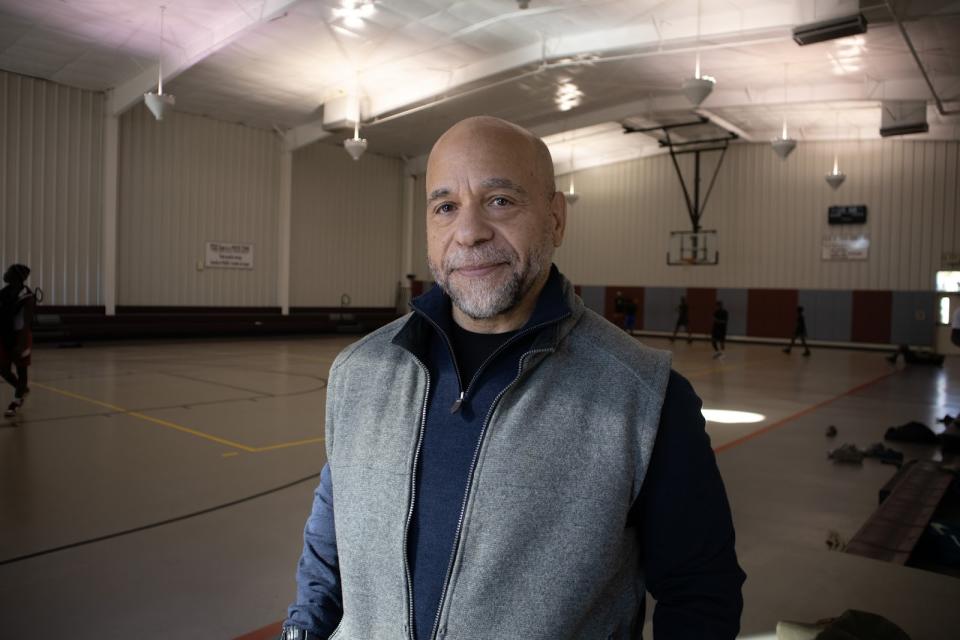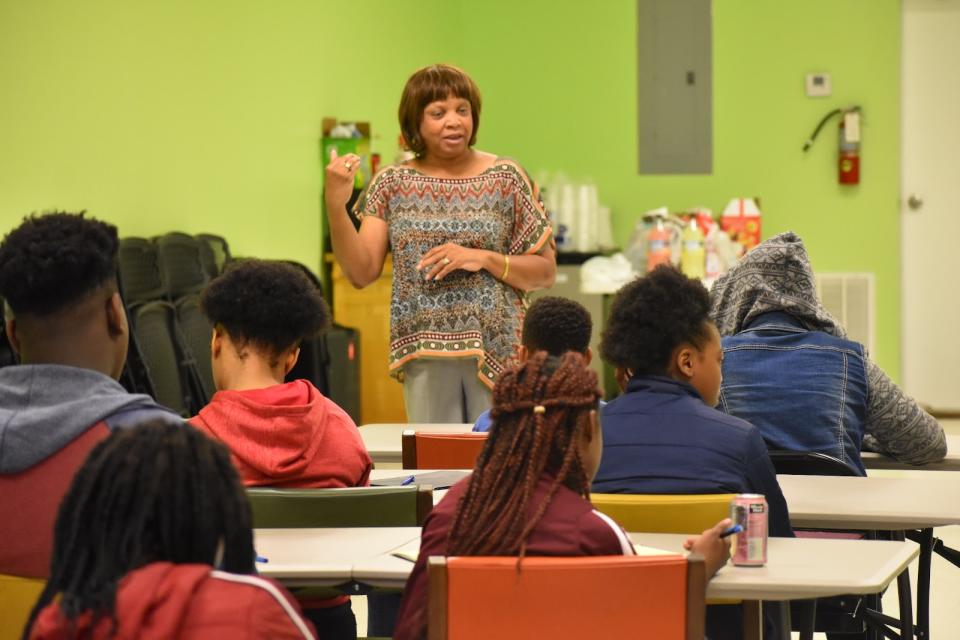How Black Rural Americans Navigate Internet Issues
This is the second story in Capital B’s “Disconnected: Rural Black America and the Digital Divide” project, which explores the disparate effects of broadband accessibility on Black Americans in the rural South. This project is made possible by a grant from The Center for Rural Strategies and Grist. You can read our first story, “Digital Redlining and the Black Rural South,” here.
SELMA, Ala. — On a warm afternoon in September, residents sit outside the Selma Dallas County Library, or in the parking lot in their cars, to connect their mobile phones to the library’s hotspot.
It’s rather quiet except for the sounds of muddled conversations and car engines in this Alabama town that became an epicenter for a turning point in the Civil Rights Movement. Less than a mile away from the library is the Edmund Pettus Bridge, the site of “Bloody Sunday” where 600 people were brutally battered and beaten by police officers for marching to secure voting rights. Nearly 60 years later, residents in the 84% Black town say they still struggle to obtain a basic service: adequate internet access.
Crystal Drye, who has worked at the library since the days of typewriters, says this is the norm. For some, it’s too costly to subscribe to internet service, the speeds are too slow, or they lack the skills to navigate an online landscape. As a solution, they stop by the library, said Drye, who serves as the technology director.
She knew the service became critical when residents came to watch funeral services, hop on Zoom calls, or watch graduation ceremonies. Even homeschooled students often utilize the resources. The library also purchased laptops and mobile hotspots to assist older residents and people with disabilities at their residences.
“I’ve taken our laptops to the nursing home so that a person can stream [church] service on Sunday,” Drye told Capital B. “I’ve taken it to a person to use to order their groceries when they need to because maybe they can’t drive to get it. … It’s nice that we can be a one-stop shop.”
This is a similar reality for millions of residents living without high-speed internet — especially Black folks in the rural South, where the digital divide is the greatest. In this region, about 38% of Black households don’t have home internet, a higher percentage than white people in the same region and the national average, a 2021 report from the Joint Center for Political and Economic Studies found. In Dallas County, where Selma is located, 17% of households do not have internet access, the same percentage statewide.
Read more: Digital Redlining and the Black Rural South
Over four months, I made several trips across Alabama, Georgia, and Mississippi and spoke to about 30 residents, experts, and advocates. Here’s how the digital divide is disrupting their everyday lives.
The high costs of low speeds
When Hans Hageman moved from New York to the Mississippi Delta to lead the Tutwiler Community Education Center last year, he didn’t anticipate his internet would affect his productivity. On a daily basis, he juggles between whether his home in Rome, an unincorporated community, or the education center in Tutwiler would be better suited for Zoom or phone calls.
He’s missed out on potential funding opportunities because he can’t upload grant applications online due to slow speeds.
“It’s always top three on the list of, ‘Is this going to work today?’” Hageman said. “I have a meeting this weekend and I have to be prepared to close my stuff and drive real fast to see if I get a better connection to make a $25,000 ask to a foundation. I could be much more productive if I wasn’t doing that.”
He’s also noticed how the inadequate service limits opportunities for the youth to participate in virtual or global activities. Hageman signed up his students for a digital sports tournament to compete with youth nationwide. During a Zoom training ahead of the tournament, his students kept “dropping off of the call” due to bad internet connections, which forced them to miss out.
Some of the kids in the 79% Black town of 3,000, want to pursue careers in content creation, media, and photography. They have dreams of being fashion designers, chefs, and entrepreneurs. He’s also working to put together a robotics program and a drone pilot program. In the back of his mind, Hageman knows they “don’t have the bandwidth to pull this off” because of the challenges with broadband.
Unfortunately, it adds to the many reasons why they want to leave their town — a place described as a food, job, and medical desert. The only place to get food is the Double Quick gas station.
“When you’re talking to the kids, none of them want to stay, and some of it is because of their access,” Hageman told Capital B. “It breaks my heart because when they go off, they are having to play catch up.”
Despite the barriers, Hageman is on a mission to figure it out.

At the height of the pandemic, nonprofit leader Gloria Dickerson learned that many families in her hometown of Drew, Mississippi — which is about 16 miles from Tutwiler and 11 miles from Rome — didn’t have access to computers or internet at home due to affordability.
The Sunflower County School District provided one mobile hotspot per household and one tablet per child. The costs of insurance — $5 for hotspot and $25 per tablet — rested on families. In households with multiple children, the fees were too costly, and one hotspot was simply not enough. Some children could not complete schoolwork at home, which caused some students to fall further behind, she said.
“Every child needs a computer at home. I see these computers as for information, but I also see it as a learning tool for the younger generation … to keep up with what’s going on in the world. Keep up with their homework. It’s just a necessity,” Dickerson said. “We can’t do it and expect these kids to thrive.”

Dickerson, who runs We2gether Creating Change in downtown Drew, opened her doors for children to use computers, and purchased iPads for every student in her program. At her building, she had a stable internet connection. About five minutes away at her home, her internet service was poor.
“It got so bad that I couldn’t watch TV. Every 10 minutes, it would go off and say it couldn’t connect. I’d call, and they’ll say, ‘Well, we can’t find anything wrong with it, maybe you need to just hit the reset button,’” Dickerson said. “You just get so disconnected. Every time you start to send an email, all of sudden it goes down in the middle of sending an email. Did that email send? Should I resend the email? It’s a mess.”
The service, which costs $75 monthly, should be better for how expensive it is, she told Capital B in September. A month before, she says, a technician finally came out, after a year and a half of calls.
Community resources aren’t available to all
In Devereux, Georgia, where Gloria Simmons has lived for over 50 years, there’s not much except a Dollar General and a few churches. She often travels for basic services, but this year, she decided the internet could help cut down on trips, specifically to pay bills and access bank statements.
One of the reasons she held out on getting the service was her lack of digital skills. Instead of relying on her daughter, who works full time, Simmons wanted to learn how to navigate the internet herself.
“We get complacent and dependent upon others. I like to try to set it up where I can at least do it and do some things on my own,” Simmons told Capital B at her home.
But, as a retiree on a fixed income, it’s too expensive, she says. She pays $60 a month for fixed wireless internet with AT&T. But some months, if she goes over her data usage, it’s $10 for each additional 50 gigabytes of data. If it increases, she says she’ll cancel the service, despite its convenience.
Back in Alabama, Henry Hall Jr. has switched back and forth between AT&T and Spectrum, formerly Charter, for years. They are two of the largest internet companies worldwide and the only options available to him. He lives in a remote area in the countryside of Selma, surrounded by trees, and his service is always “buffering,” he said. He walks nearly 20 minutes to the Selma library to use the computer and printer. Drye calls him a regular because he’s there so much.
The Selma library and the nonprofits led by Dickerson and Hageman help to provide resources to their communities to access the internet. However, many communities don’t have those resources.
In 2021, President Joe Biden signed into law the Infrastructure Investment and Jobs Act, which authorized $65 billion to fix broadband issues, including infrastructure, affordability, and digital literacy. Of that, $42.5 billion goes to states through the Broadband Equity, Access, and Deployment (BEAD) program.
Currently, each state is planning how to disperse the funds, but the rollout will happen over the next four years or so. Given the history of neglect to Black communities, residents question whether the billions of dollars from the feds for broadband will reach their area.
While Hall enjoys his library visits, he hopes the federal government’s initiatives will result in better service for residents.
“It’s unfortunate that when you use the internet, it’s buffering, or if there’s too many people trying to get in on it at one time, the internet … it becomes stagnant,” he added. “As long as I get the quality, I can use the internet when I need to use it, and that’s what I would like.”
The post How Black Rural Americans Navigate Internet Issues appeared first on Capital B News.

